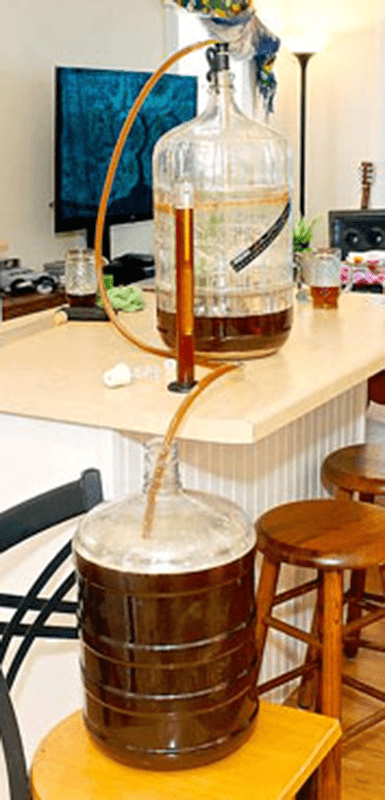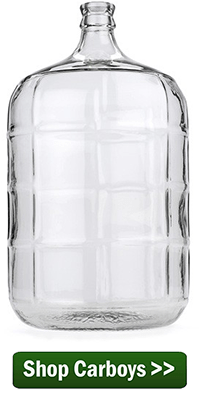 Many homebrewers consider a secondary fermentation to be a worthwhile step when brewing beer. For the time it takes to move a batch of beer from a primary fermenter to a secondary fermenter, it offers a number of opportunities to improve your homebrew and make the best beer that you can.
Many homebrewers consider a secondary fermentation to be a worthwhile step when brewing beer. For the time it takes to move a batch of beer from a primary fermenter to a secondary fermenter, it offers a number of opportunities to improve your homebrew and make the best beer that you can.
Check out these ten tips for putting your beer through a secondary fermentation. Most are just suggestions, but the first is imperative:
- Sanitation, sanitation, sanitation – Don’t spoil you hard work by being lax at this stage! Thoroughly clean and sanitize the secondary fermenter as well as your hoses and tubing used to transfer the beer. Be sure to sanitize the airlock as well and fill with either clean water or a diluted vodka solution.
- Use an Auto-Siphon – Transferring the beer is much easier with an Auto-Siphon. It’s one of the most cost-effective upgrades you can make as a homebrewer. The Auto-Siphon will prime your siphon flow for you with just one pump. It’s a no-brainer for the homebrewer who routinely does secondary fermentations.
- Take a hydrometer sample – Transferring to a secondary fermenter offers a good opportunity to check in on your beer’s gravity — and while you’re at it, clarity, too. This is a good time to head off any potential issues while you still can. Remember to record the gravity in your homebrewing notes.
- Add sugars – If you find that your alcohol content is a little lower than you’d like, you can add additional sugars when putting your beer into secondary fermentation. It can be corn sugar, brown sugar, honey, or dried malt extract…any fermentable ingredient can be used to boost gravity. Most should be dissolved in clean, sterile water before mixing.
- Add clarifiers – Many brewers choose to add finings, or clarifiers, when doing a secondary fermentation on their beer. Gelatin or isinglass may be added at this stage.
- Add water
 – If you find you’re short on volume and can afford to spare some alcohol content, you may want to mix in a small amount of sterile water to the fermenter. Boil the water for 20 minutes and allow to cool to the temperature of the beer, stirring it in using a sanitized spoon. Use a dilution calculator to figure out how much water to add.
– If you find you’re short on volume and can afford to spare some alcohol content, you may want to mix in a small amount of sterile water to the fermenter. Boil the water for 20 minutes and allow to cool to the temperature of the beer, stirring it in using a sanitized spoon. Use a dilution calculator to figure out how much water to add.
- Add dry hops – A secondary fermentation is also an opportunity to boost your beer’s hop flavor and aroma. Check out our Quick Guide to Dry Hopping Your Homebrew Beers for advice.
- Add herbs or spices – Just like dry hopping, you can “dry spice” your homebrew with herbs and spices. Remember: a little goes a long way!
- Keep the temperature stable – Big swings in the secondary fermentation temperature can lead to off-flavors. Read these tips for controlling homebrew fermentation temperatures.
- Try it in the keg – If you’re set up with a homebrew draft system, you can do a secondary fermentation right in the keg. Sediment at this stage will be minimal, just keep the keg vent open so the fermentation does not build up to much pressure. Then all you have to do is force carbonate after the secondary fermentation period.
What other techniques do you use during your beer’s secondary fermentation to ensure a successful homebrew?
—–
David Ackley is a beer writer, brewer, and self-described “craft beer crusader.” He holds a General Certificate in Brewing from the Institute of Brewing and Distilling and is founder and editor of the Local Beer Blog.

Great articles !
How much sugar would you recommend adding to a 5 gallon batch during a transfer to a secondary?
Bryce, if you are asking about increasing the alcohol content, the amount of sugar to add would depend on how much you want to raise the alcohol content of the finished beer. You can use this as a guideline, when using corn sugar, the addition of one pound in a 5-gallon batch will raise the potential alcohol by about one percent.
Increase The Alcohol Of Your Homebrew
http://www.eckraus.com/blog/raise-increase-alcohol-content-homebrew
Secondary is not a thing. There is not enough good science to back up secondary fermentation. What does it accomplish that couldn’t be accomplished in packaging?
Roger, there are both pros and cons to a secondary fermentation. Bothe are discussed in the article posted below.
Pros And Cons Of Using A secondary Fermentation
http://blog.eckraus.com/adding-beer-to-secondary-fermentation-necessary
If adding corn sugar to boost ABV, do you need to repitch yeast, or is there generally enough residual?
Thanks!
Elijah, you do not need to add any additional yeast. There should be enough yeast still present to ferment the additional sugar.
My understanding is: to add further fermentables (sugars not malted) say brown sugar to add flavour as well as alcohol increase, it is best to add when first vigourus fermentation is slowed/ finished maybe 1 air release every 10mins.This would allow malt sugars to be assimilated first, imparting flavours of the mash/malt specifics. The secondary sugar addition would then be assimilated in its own way, by the yeast and not causing a faulty “fast” sugar assimilation overriding the original mash/malt sugars. Keeping yeast active is in my opinion a primary factor to good fermentation. Complex carbs, simpler carbs. Adjuncts if used, can be added to the true secondary fermentation, whilst conditioning takes place before serving. Prime as normal.
Hello, I read your post. it’s too good. the main thing I see in your blog is the way of providing the information. Your post is very informative for a beer lover. keep sharing
Thank you. Good, simple information.
For adding cinnamon sticks, cocoa nibs, prunes, and dried peppers: how important is it to sanitize them? Can I rely on the beer’s alcohol and dried nature of the adjunct to keep wild yeast/bacteria from growing?
Andrew, if you are adding these items prior to fermentation, there is no need to do so. However, if you plan to add them after fermentation completes, we would recommend blanching them before adding to the beer.